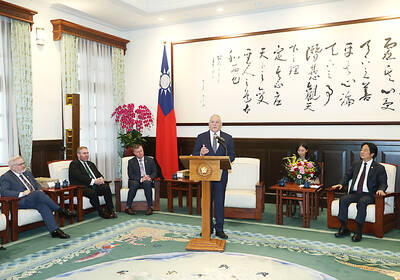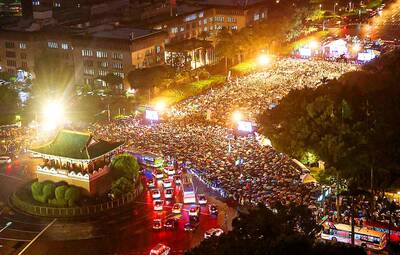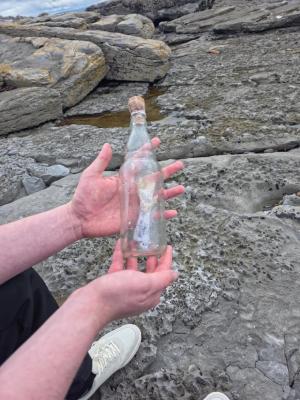Hu Nai-yuan and Shih Wen-miao received an unusual kind of cake when they celebrated their birthdays recently in Taoyuan Township (桃源), Kaohsiung County.
The “cake” — made of silt and soil — was a special request by the two paratroopers, who have been working in the devastated township as part of post-Typhoon Morakot cleanup operations. Their birthday wish, meanwhile, was that survivors could rebuild their homes quickly.
Hu, 23, and Shih, 22, were born one year apart on Aug. 23, and normally would celebrate their birthdays with parties.

PHOTO: CNA
“This is the first time I’ve spent my birthday this way. I will not forget this for the rest of my life,” Hu said.
Other servicemen may have to celebrate special occasions in disaster areas if the military makes disaster relief one its core missions, as President Ma Ying-jeou (馬英九) has suggested.
The military’s increasing participation in disaster relief operations is a given, considering Taiwan’s vulnerability to earthquakes and typhoons, and its lack of preparation for major disasters was exposed by Morakot.
But at least the performance of rank-and-file soldiers like Hu and Shih put to rest speculation that the current generation of soldiers is too soft to handle rescue tasks, such as those they faced in Taoyuan Township.
The township was one of the eight mountainous residential areas along the Southern Cross-Island Highway cut off during the storm.
As of Aug. 26, there were still 135 military officers and privates in the town, where drinking water and electricity had not yet been restored. They were working to clear rocks and mud, bathing in streams and sleeping in a damaged elementary school.
Asked whether they were tired, the two birthday boys responded, “Not at all.”
This spirit of endurance was common among the tens of thousands of soldiers who were working in typhoon-devastated zones.
In Linbian (林邊) and Jiadong (佳冬) townships in Pingtung County, hundreds of new recruits have been struggling to clean up millions of tonnes of mud and debris left behind by Morakot-triggered flooding.
“Never before in all my 20 years have I ever had to shovel stinking mud,” a new artillery recruit said.
One of his buddies agreed.
“The smell of rotting fish remains on me even after I’ve washed six times with an aromatic soap,” he said with a sigh.
Some soldiers have developed rashes while several others have sustained injuries to their hands or legs during work. But they remain undaunted and have vowed to stay in the disaster zones until the cleanup work is complete.
“As long as we can see mud, we will not leave,” they said.
Their hard work has won the hearts and minds of survivors.
“Without the armed forces’ help, I would not have been able to clear all this mess,” said one tire shop owner, surnamed Tsai, whose premises were covered with silt and mud.
Tsai said he cannot express the gratitude he feels at seeing the soldiers operating backhoes or using shovels to move head-high piles of soft sticky earth away from his house.
Yet while survivors have been unanimous in their praise of the troops’ dedication to the post-typhoon rescue and relief work, some observers have criticized the military leadership’s response in the early stages of the disaster as slow and inept.
“The Morakot disaster exposed flaws in the military’s rescue and relief operations ... The upper levels of command responded too slowly,” said Lin Chong-pin (林中斌), a military strategist who once served as deputy head of the Mainland Affairs Council and later as deputy defense minister.
In many places, he said, troops were standing by to begin the rescue and relief work, but they did not receive orders.
Other analysts have agreed that the military’s response in the first three days after the storm was a far cry from its performance over the 20 days that followed.
The military later mobilized tens of thousands of soldiers and launched roughly 400 helicopter missions per day in its rescue and relief operations. This was seen as an indication that the military has adequate post-disaster response mechanisms and capabilities.
The question is whether the military is prepared to make disaster relief one of its core missions, on a par with combat readiness.
Military authorities have argued that the criticism leveled at them was unfair.
The military set up a typhoon emergency response center on Aug. 5 and Minister of National Defense Chen Chao-min (陳肇敏) hosted a teleconference at the Hengshan Command Center in Taipei late on Aug. 6 with commanders in various operational regions.
During that meeting, Chen asked them to assist local governments in rescue and relief work by dispatching personnel or equipment as needed.
Possibly because military headquarters and regional commanders had different understandings of the minister’s order, several local governments complained about the military’s reluctance to support them in evacuation and rescue work at the height of the flooding.
Lin said the disaster was a cue for commanding officers to change their mindset and concepts and keep abreast of new trends.
The speed of the military’s disaster response and actions as well as the leadership’s relief operation command actually reflect its overall combat capability and has become a major element in evaluating the combat prowess of a country’s armed forces, Lin said.
One such evaluation was a confidential report by the Center for Intelligence Research and Analysis, a Washington-based think tank, on the rescue and relief effort by the People Liberation Army (PLA) in the wake of the Sichuan earthquake, which killed at least 68,000 people last year.
Since the Sichuan earthquake, China’s military leadership has on many occasions stressed the PLA’s role in disaster relief, Lin said, citing the report.
“The military should adjust its personnel structure, budget allocation, arsenal and equipment procurement as well as the content of training programs,” Lin said.
Meanwhile, Chen Wen-cheng (陳文政), a researcher with the New Society for Taiwan, said the military’s experiences in the Morakot relief operation were as valuable as the annual Han Kuang military exercise covering computerized war games and live-fire exercises over the past decade.
Many scenarios in the relief operation were similar to scenes simulated in Han Kuang exercises, such as troops from the north coming to the rescue of the south and the entire command and communication system being cut off.
“If the post-Morakot relief is regarded as part of the Han Kuang annual training exercise, there is ample room for improvement in the military’s C4ISR,” Chen said, referring to the command, control, communication, computer, intelligence surveillance and reconnaissance system.
There has been no armed conflict in the Taiwan Strait for half a century, but natural disasters happen nearly every year. Chen said the military should adjust its training programs to hone its disaster relief skills.
“This is a general world trend. Major countries around the world have listed disaster relief and humanitarian aid as primary missions of their armed forces,” he said.
And that will likely mean more silt and soil cakes for servicemen.

‘NON-RED’: Taiwan and Ireland should work together to foster a values-driven, democratic economic system, leveraging their complementary industries, Lai said President William Lai (賴清德) yesterday expressed hopes for closer ties between Taiwan and Ireland, and that both countries could collaborate to create a values-driven, democracy-centered economic system. He made the remarks while meeting with an Irish cross-party parliamentary delegation visiting Taiwan. The delegation, led by John McGuinness, deputy speaker of the Irish house of representatives, known as the Dail, includes Irish lawmakers Malcolm Byrne, Barry Ward, Ken O’Flynn and Teresa Costello. McGuinness, who chairs the Ireland-Taiwan Parliamentary Friendship Association, is a friend of Taiwan, and under his leadership, the association’s influence has grown over the past few years, Lai said. Ireland is

FINAL COUNTDOWN: About 50,000 attended a pro-recall rally yesterday, while the KMT and the TPP plan to rally against the recall votes today Democracy activists, together with arts and education representatives, yesterday organized a motorcade, while thousands gathered on Ketagalan Boulevard in Taipei in the evening in support of tomorrow’s recall votes. Recall votes for 24 Chinese Nationalist Party (KMT) lawmakers and suspended Hsinchu City mayor Ann Kao (高虹安) are to be held tomorrow, while recall votes for seven other KMT lawmakers are scheduled for Aug. 23. The afternoon motorcade was led by the Spring Breeze Culture and Arts Foundation, the Tyzen Hsiao Foundation and the Friends of Lee Teng-hui Association, and was joined by delegates from the Taiwan Statebuilding Party and the Taiwan Solidarity

An SOS message in a bottle has been found in Ireland that is believed to have come from the Taiwanese captain of fishing vessel Yong Yu Sing No. 18 (永裕興18號), who has been missing without a trace for over four years, along with nine Indonesian crew members. The vessel, registered to Suao (蘇澳), went missing near Hawaii on Dec. 30, 2020. The ship has since been recovered, but the 10 crew members have never been found. The captain, surnamed Lee (李), is believed to have signed the note with his name. A post appeared on Reddit on Tuesday after a man

Instead of threatening tariffs on Taiwan-made chips, the US should try to reinforce cooperation with Taiwan on semiconductor development to take on challenges from the People’s Republic of China (PRC), a Taiwanese think tank said. The administration of US President Donald Trump has threatened to impose across-the-board import duties of 32 percent on Taiwan-made goods and levy a separate tariff on semiconductors, which Taiwan is hoping to avoid. The Research Institute for Democracy, Society, and Emerging Technology (DSET), a National Science and Technology Council think tank, said that US efforts should focus on containing China’s semiconductor rise rather than impairing Taiwan. “Without